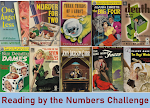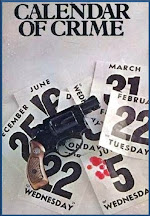Since last October, I have read books by such Club luminaries as Agatha Christie, Ronald A. Knox, Gwendoline Butler, Nicholas Blake (Cecil Day-Lewis), Michael Innes (J.I.M. Stewart), John Dickson Carr, E. C. R. Lorac (Edith Caroline Rivett), Patricia Moyes, Ruth Rendell, and Elizabeth Ferrars (Morna Doris McTaggart). For the purposes of this challenge, I am highlighting only those authors whose work I read was published during Noah's stipulated time period (through the 1950s). That narrows it down to Christie, Innes, Blake, Knox and Lorac.
Christie, of course is one of the most well-known detective novelists of all time and certainly one of the most recognized authors of the Golden Age. Even folks who claim no love for the mystery story tend to know who Agatha Christie is. She was one of the founding members of the Detection Club along with Ronald A. Knox (more on him later) and others and is recognized as one of the "Queens of Crime." Her reign over the detection field comes in part from her output--her career spanned over 50 years with her first mystery novel, The Mysterious Affair at Styles, published in 1920 and with a final book (Sleeping Murder) published posthumously in 1976. But she was also the queen of plot twists. She found more ways to use standard mystery plot devices than would seem to be possible and devised devious twists which has caused more than one critic to cry "Unfair!"

The works of Christie which I read over the past year included The Underdog and Other Stories (1951) and The Labors of Hercules (1947), two collections of short stories, as well her novel The A.B.C. Murders (1936). One thing that struck me about The Underdog collection was how much Christie was following the Holmesian short story model. All but one of the stories are told by Captain Hastings in the same narrative-journal format that Dr. Watson uses. And Poirot uses some Holmes dramatic flair to wrap up a few of the cases. He is much more active in tracking down clues (despite talking about the psychology and the little grey cells)...or at least giving the appearance of doing so. In "The Submarine Plans" he even devotes time to the search for footprints. Labors was a fun collection of stories and built very nicely upon the classical twelve labors conceit. The only unfortunate part is that in order to fulfill his tasks, Poirot has to travel a bit more than usual, but all things considered it is impressive how many of the stories did manage to stay close to home for our detective. The A.B.C. Murders was a "reread" for me (in quotes because I actually listened to an audio version of a BBC production). Christie provides for us her particular take on the serial killer. It was very interesting to listen to Christie work her magic and hear Poirot explain how he gets into the mind of the killer to discover who s/he is.
Michael Innes, the pen name for the Oxford don J.I.M. Stewart, wrote, as might be expected from an academic, mystery stories with a very literary bent--full of quotations and mischievous wit. Sometimes that wit can be a trifle obscure and fanciful and one needs to be prepared for the slightly off-the-wall plots and story lines in a few of the titles (The Open House comes to mind). In Bloody Murder, Julian Symons identified Innes as one of the "farceurs"—crime writers for whom the detective story was "an over-civilized joke with a frivolity which makes it a literary conversation piece with detection taking place on the side." If you like your mysteries with a bit of unusual humor, then Innes is definitely an author worth looking for.
 Lament for a Maker (1938) is often regarded as one of Innes's best books and has been praised as such by fellow mystery writers Nicholas Blake and Michael Gilbert. Unfortunately, I didn't find it as engaging. While
I will agree that the mystery itself is quite nicely twisty and
surprising, the journey he takes the reader on to get to that brilliant,
twisty ending is a rather arduous one. The tale is told through the
narratives of various characters--five in all, including his detective
John Appleby--and wading through the Scots dialect of the opening
narrative nearly put me off entirely. Definitely worth reading for the mystery itself, but not, to my mind, one of Innes' absolute best. I've rated Death at the President's Lodgings, The Weight of the Evidence, and The Long Farewell
each higher. I did enjoy being fooled by the final twist and I found
the narrative threads by Noel Gylby and Appleby to be the most
entertaining.
Lament for a Maker (1938) is often regarded as one of Innes's best books and has been praised as such by fellow mystery writers Nicholas Blake and Michael Gilbert. Unfortunately, I didn't find it as engaging. While
I will agree that the mystery itself is quite nicely twisty and
surprising, the journey he takes the reader on to get to that brilliant,
twisty ending is a rather arduous one. The tale is told through the
narratives of various characters--five in all, including his detective
John Appleby--and wading through the Scots dialect of the opening
narrative nearly put me off entirely. Definitely worth reading for the mystery itself, but not, to my mind, one of Innes' absolute best. I've rated Death at the President's Lodgings, The Weight of the Evidence, and The Long Farewell
each higher. I did enjoy being fooled by the final twist and I found
the narrative threads by Noel Gylby and Appleby to be the most
entertaining.Speaking of Nicholas Blake, that nom de plume served British poet and Poet Laureate of the United Kingdom Cecil Day-Lewis for his detective novel career from 1935-1968. His work tends to reflect his poetic abilities--the best of his books have a lyrical quality that comes with terrific descriptions and language as well as good dialogue. He sets up a pretty twisty plot as well. My favorites so far are The Morning After Death and A Question of Proof--which really should surprise no one who knows me since both of these have academic connections. This past year I read Head of a Traveller and The Smiler with the Knife.
The first was one of the few disappointments I've read at the hands of Blake. Much as I generally love Blake's writing and plotting, the whole story just came across as a convoluted mess. Much more convoluted than necessary for the purposes of mystifying the reader--I didn't feel mystified. I felt frustrated with everything from the opener (Nigel Strangeways's journal entry--in first person present while the rest of the novel is in past tense) to the bizarre characterizations (a gibbering dwarf? seriously?). This one was quite simply not up to Blake's usual par--at least not for me. Others have rated it quite highly, so your mileage may vary.
 Smiler was a slight departure from the usual Blake fare. Instead of focusing on Strangeways, this novel gives us an enjoyable political thriller with a very resourceful heroine indeed--Nigel's wife Georgia. Georgia
handles herself rather well among the hush-hush cloak and dagger types
and uses great ingenuity to get herself out of some rather tight places.
She dresses up as everything from Father Christmas to a Radiance Girl
(a cross between an interpretative dancer and a New Age devotee) and is
aided by adventurer-wannabes like the manager of a well-known department
store and a plucky vicar's wife. There's a cross-country chase and
Georgia manages a rather MacGyver-style escape. It's all great fun and a
thrilling adventure all in the name of foiling the fascist bad guys. No
great mysteries here, just a straight political thriller complete with
evil master mind and henchmen. A topical story for the times which has
held up very well.
Smiler was a slight departure from the usual Blake fare. Instead of focusing on Strangeways, this novel gives us an enjoyable political thriller with a very resourceful heroine indeed--Nigel's wife Georgia. Georgia
handles herself rather well among the hush-hush cloak and dagger types
and uses great ingenuity to get herself out of some rather tight places.
She dresses up as everything from Father Christmas to a Radiance Girl
(a cross between an interpretative dancer and a New Age devotee) and is
aided by adventurer-wannabes like the manager of a well-known department
store and a plucky vicar's wife. There's a cross-country chase and
Georgia manages a rather MacGyver-style escape. It's all great fun and a
thrilling adventure all in the name of foiling the fascist bad guys. No
great mysteries here, just a straight political thriller complete with
evil master mind and henchmen. A topical story for the times which has
held up very well.Monsignor Ronald A. Knox in his religious capacity served as chaplain to Oxford--providing suitable Catholic lectures when C. S. Lewis and J. R. R. Tolkien trod the hallowed halls--as well as translating the Latin Vulgate Bible into English using Hebrew and Greek sources. But in his spare time, he was a founding member of the Detection Club, penned the Ten Commandments of Detective Fiction which outlined basic principles that authors were supposed to follow in order to "play fair" with their readers, and authored six detective novels--five of which feature Miles Bredon. Bredon is an investigator who is often called upon by the Indescribable Insurance company to investigate suspicious circumstances connected with their insurance policies.
 Double Cross Purposes is the last of the Bredon novels. It
is a quite lovely Golden Age Detective story--in every sense of the
word. It was written between the wars, it's fairly clued, and it has a
nifty, intricate puzzle plot. What more could a GAD-lover want? It has
disguises and maps and suspicious chauffeurs. It has a curse on the
treasure and a missing key. There is minister who seems a tad too
interested in the treasure hunt which lies at the center of the mystery and policemen who don't seem interested
enough in dead bodies. The banter between Bredon and his wife is witty
and I enjoyed their good-natured teasing of their schoolmaster friend.
Poultney is every inch the pedant (who will tell you the origins of any
word or phrase at the drop of a hat), but he is also an over-grown
school boy just dying to play at sleuth hound with big kids. He is
utterly delightful when he discovers a major clue and springs it upon
Bredon. I had a great deal of fun with this one even though I guessed
part (but not all!) of the solution.
Double Cross Purposes is the last of the Bredon novels. It
is a quite lovely Golden Age Detective story--in every sense of the
word. It was written between the wars, it's fairly clued, and it has a
nifty, intricate puzzle plot. What more could a GAD-lover want? It has
disguises and maps and suspicious chauffeurs. It has a curse on the
treasure and a missing key. There is minister who seems a tad too
interested in the treasure hunt which lies at the center of the mystery and policemen who don't seem interested
enough in dead bodies. The banter between Bredon and his wife is witty
and I enjoyed their good-natured teasing of their schoolmaster friend.
Poultney is every inch the pedant (who will tell you the origins of any
word or phrase at the drop of a hat), but he is also an over-grown
school boy just dying to play at sleuth hound with big kids. He is
utterly delightful when he discovers a major clue and springs it upon
Bredon. I had a great deal of fun with this one even though I guessed
part (but not all!) of the solution.And, finally, E. C. R. Lorac. Edith Caroline Rivett wrote about eighty detective novels under two pen names--E.C.R. Lorac and Carol Carnac. Her primary detective under the Lorac name was Chief Inspector (and later Superintendent) Robert MacDonald, a London Scot who often is assisted by Detective Inspector Reeves among others.Her books are police procedurals, but they are no plodding affairs. There are generally plenty of clues and red herrings strewn about and GAD readers will definitely feel like the detective rules have been fairly played by. Lorac can be a bit difficult to find (especially if, like me, you like to discover your books "in the wild" of used books stores, rather than online), but I have been fortunate to find a handful.
My most recent Lorac read was The Case of Colonel Marchand in which Macdonald is called upon when the Colonel is found dead in his well-appointed drawing room after he has entertained a beautiful young woman at an elaborate tea. I enjoyed this one immensely. Unfortunately, unless I provide you all with a huge spoiler, I can't tell you why I love this one so much. Let's just say that Lorac makes good use of a standard mystery trope and pulls it off with aplomb and fair play. She displays the clues for the reader and, really, as a long-time reader of Golden Age mysteries, I'm well enough acquainted with the customs of the times that I should have recognized the primary clues paraded under my nose. But I didn't--and that makes it all the more fun. I thoroughly enjoyed Macdonald's investigations into the amorous Colonel's life and the Inspector's interactions with various peripheral characters. Nicely plotted. A highly recommended entry in Lorac's mystery offerings.
The Detection Club has had and currently has among its members so many fine mystery writers. Of the over 150 writers who have been added to the roll since it was formed in 1930, I've had the great good fortune to read works by at least 80 of its members. There is enough variety in the styles and methods to satisfy just about any taste in detective fiction. If you enjoy a good mystery and haven't given the folks on the Club list a try, you have a treat in store.
This is my final offering in Noah's October 8 Challenge. With square B-1, I have finished my personal commitment to complete at least one Bingo before October 8.































1 comment:
very interesting Bev. I have enjoyed all the posts that you have written for this challenge.
Post a Comment